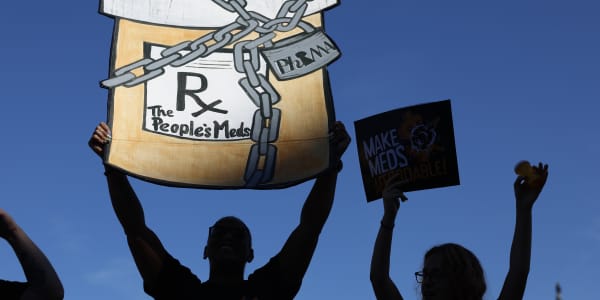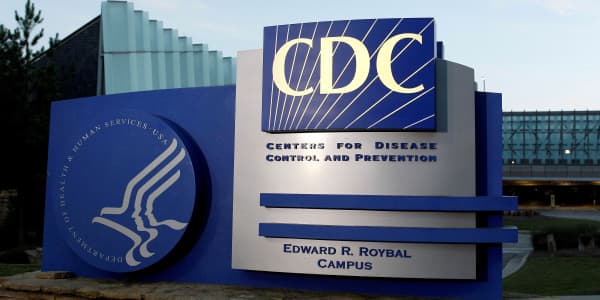Think a friend or colleague should be getting this newsletter? Share this link with them to sign up.
Good morning! Millions of Americans with a common and potentially life-threatening form of liver disease will soon have access to the first-ever treatment for the condition.
In a landmark decision on Thursday, the Food and Drug Administration approved Madrigal Pharmaceuticals' drug "Rezdiffra," to be used along with diet and exercise. The company expects the medicine to be available next month with a hefty price tag of $47,400 per year before insurance and other rebates.
So, why is this approval so important?
First of all, people suffering from the disease badly need a treatment. Rezdiffra is specifically approved to treat patients with nonalcoholic steatohepatitis, or NASH, who also have moderate-to-advanced liver scarring.
Some specialists have started calling the condition metabolic dysfunction-associated steatohepatitis, or MASH, to avoid potentially stigmatizing language.
MASH is a serious form of liver disease characterized by excess fat buildup and inflammation. It can lead to liver scarring and in more severe cases, liver failure or cancer. The condition is often associated with other health problems, such as high blood pressure, Type 2 diabetes and obesity.
Roughly 6 million to 8 million people in the U.S. have MASH with moderate-to-advanced liver scarring, according to an estimate cited by the FDA.
The agency's approval is also a big deal because it means Madrigal has succeeded in an area where several other drugmakers have failed – or are still trying to crack.
That gives Madrigal an edge in a market that could be huge: The MASH industry could be worth nearly $26 billion by 2032 across the U.S., France, Germany, Italy, Spain, the U.K. and Japan, according to an estimate from data analytics firm GlobalData.
Madrigal's drug is setting the bar for efficacy and safety for MASH treatment, while also opening the door for medicines still in development.
There's one important detail in the approval that could bode well for the entire MASH space: The FDA isn't requiring patients to get a liver biopsy to determine their eligibility for Madrigal's drug.
That refers to a procedure in which a doctor removes a small piece of liver tissue from a patient so they can examine it under a microscope for signs of damage or disease.
"The absence of liver biopsy requirement in Rezdiffra's label should buoy biotech stocks" of companies developing MASH treatments and "potentially accelerate and broaden patient access," William Blair analyst Andy Hsieh wrote in a note Friday.
There are a handful of biotech companies with promising experimental MASH treatments:
- Akero Therapeutics released positive mid-stage trial data on its drug efruxifermin earlier this month and is studying the treatment in late-stage trials.
- Viking Therapeutics is studying a drug called VK2809 in mid-stage trials, with 52-week biopsy data expected in the first half of the year.
- 89bio is studying and planning late-stage trials on its drug pegozafermin.
- Aligos Therapeutics is studying a drug called ALG-055009 in mid-stage trials.
But the question for all of those companies is how much a blockbuster class of drugs called GLP-1s will dominate the MASH market.
GLP-1s work by mimicking a hormone produced in the gut to suppress a person's appetite and regulate blood sugar.
They include Novo Nordisk's weight loss drug Wegovy and diabetes treatment Ozempic. Eli Lilly's respective weight loss and diabetes injections Zepbound and Mounjaro are also part of the class, but target an additional hormone called GIP.
- Novo Nordisk is studying semaglutide, also known as Wegovy and Ozempic, in a late-stage trial for treating MASH.
- Eli Lilly released positive mid-stage data on tirzepatide, also known as Zepbound and Mounjaro, in treating MASH, and expects to present full data from that trial later this year.
- Zealand Pharma and Boehringer Ingelheim released positive mid-stage data on an experimental drug called survodutide in MASH patients. The companies are also studying the treatment in late-stage trials as a treatment for obesity. The treatment activates GLP-1 and another hormone called glucagon.
- Merck is studying a drug called efinopegdutide in mid-stage trials. The treatment activates GLP-1 and another hormone called glucagon.
Mizuho healthcare equity strategist Jared Holz wrote in an email to investors Friday that GLP-1 uptake is one factor that will be "key regarding the broader NASH thesis."
He said that's because "there is no doubt in our minds that the use of the weight-loss therapies will greatly reduce liver fat and would expect many doctors (at least primary care) to opt for GLPs first, before referring patients to specialists."
Wegovy, Ozempic, Zepbound and Mounjaro are already pricey at around $1,000 per month, or around $13,000 annually, before insurance and other rebates. But that's still far less than the nearly $50,000 annual price tag of Madrigal's drug.
We'll likely have a better idea of what the MASH drug landscape will look like over the next year – and how big a threat GLP-1s will be – so stay tuned for our coverage!
Feel free to send any tips, suggestions, story ideas and data to Annika at annikakim.constantino@nbcuni.com.
Latest in health-care technology
Takeaways from the HIMSS conference
Perhaps unsurprisingly, generative artificial intelligence dominated my conversations at the HIMSS conference in Orlando, Florida last week.
As I raced across the exhibition floor to meet with executives from companies like Microsoft, Google, Epic Systems, GE HealthCare, Salesforce and more, the topic was quite literally hard to avoid. I walked by a random sample of around 40 vendors at the conference, for instance, and about 75% of them had the word "AI" displayed prominently on their booths.
AI's popularity at HIMSS was expected. As I mentioned in last week's newsletter, it stole the show at last year's conference, too. But this year, the conversation around the role of AI in health care had matured. Instead of discussing long-term, far-reaching applications of the technology, most of my conversations were about how it is being tested and used in practice.
The most popular use case by far was ambient clinical documentation, which came up over and over again. Ambient clinical documentation tools allow doctors to consensually record their visits with patients, and those conversations are automatically transformed into clinical notes and summaries using AI.
Companies like Microsoft's Nuance Communications, Abridge and Suki have developed these capabilities, which they argue will help reduce doctors' administrative workloads and prioritize meaningful connections with patients.
Administrative tasks are a major problem for doctors across the U.S. health-care system, as they are one of the primary drivers of burnout, according to a survey published by Athenahealth in February. As a result, health systems have a lot of interest in tools like ambient clinical documentation that could help reduce this clerical burden.
Organizations like Stanford Health Care and California-based UCI Health announced at HIMSS that they are rolling out ambient clinical documentation tools across their entire enterprises. Since automating documentation does not directly impact patients' diagnoses or care, I expect we'll see lots of similar announcements across the country this year. It's an easier, less risky way for health systems to deploy generative AI at scale.
Many of the companies I spoke with are dipping their toes into more patient-facing and diagnostic AI applications, but I think it will be a while before we see doctors and nurses widely using the technology to support their treatment decisions.
Feel free to send any tips, suggestions, story ideas and data to Ashley at ashley.capoot@nbcuni.com.







